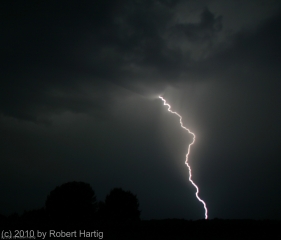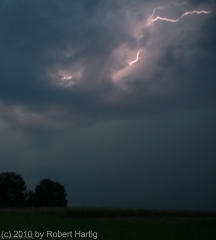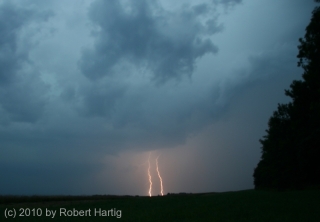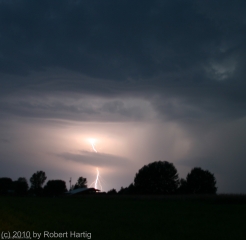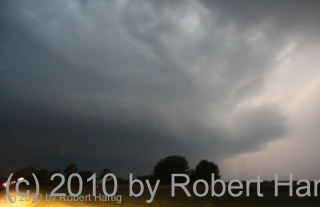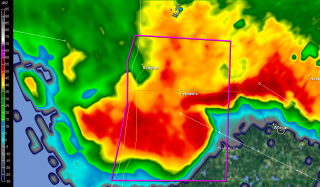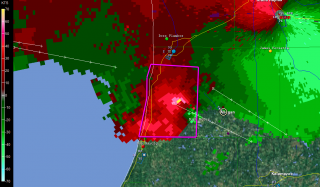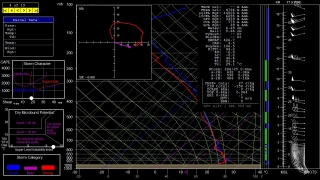It all came back to me yesterday evening, just as if I was once again sitting in the front seat of Mike Kovalchick’s Subaru Outback blasting east down US 12 in South Dakota. There it was–the Bowdle wedge, seething like a boiling, black cauldron in the field north of our vehicle. Thanks to a beautifully produced new DVD, my buddies Tom, Bill, and I relived what was unquestionably our most unforgettable chase of the year.
To the guys at Convective Addition: Bravo, gentlemen! “Bullseye Bowdle” is a superb chronicle of the amazing May 22 north-central South Dakota cyclical supercell. From the first tornado of the day, to the massive, violent Bowdle wedge, to the infamous “farmer’s field” debacle, this video provides those who chased that day with an opportunity to relive its events, and those who didn’t with the chance to drool over what they missed.
I spotted our Michigan contingent–consisting of Bill and Tom Oosterbaan, Mike Kovalchick, and me–in a number of scenes. Hey, now we’re stars! Or just walk-ins, I suppose. Getting filmed on various chase videos that day seemed almost inevitable, since everyone out there was tracking the same slow-moving storm, albeit approaching it from different angles. “Bullseye Bowdle” does a splendid job of presenting multiple perspectives on each tornado.
The storm structure that day ranged from breathtaking to unbelievable, and this video captures it all, from storm initiation to the phenomenal, bell-shaped meso with an immense cone/quasi-wedge beneath it west of Bowdle, and plenty more. Of course, the powerful Bowdle EF-4 wedge is the show’s main act. But the graceful, highly photogenic tornado that formed northeast of Bowdle after the wedge dissipated is also spotlighted, and deservedly so. If you want to get a good look at multi-vorticity, check out the braided appearance of this tornado. During its truncated tube phase, it looks as if it were literally woven out of delicate, pirouetting vortices, like a strand of yarn in which you can see all the individual threads–simply amazing, not to mention quite beautiful.
And then, yes, there is the farmer’s field. Those of us who were there will never forget it: our narrow escape from disaster, and the craziness that followed. Having survived both the tornadoes and the ensuing lunacy, each one of us has a story to tell, and it’s nice to see part of that story dramatized on film. I love the footage of the drill-press tornado! But for me, the most jaw-dropping part is Adam Lucio’s segment of a tornado forming right by the vehicles, not more than 30 feet from one of them. I failed to witness that spectacle when we were actually sitting out there in the middle of the South Dakota prairie, but the video shows it clearly. It was a moment worthy of every expletive under the sun, or in this case, the mesocyclone.
My favorite comment in the video occurs as two sets of headlights appear on the horizon, heading toward us through the darkness. Adam Lucio: “Off in the distance we can see help is on the way.” Ha! Not quite. Swap out the “P” in “help” for a second “L” and that assessment would have been spot-on. I can’t make a blanket indictment of the locals since some of them were decent folks, sympathetic, and extremely helpful, and the land owner’s initial anger was understandable; but there were others who in my opinion behaved–how shall I put this? I’ll say it delicately–like wholesale, unmitigated, gold-gilded, rhinestone-encrusted, butt-drunken, power-abusing, 24-karat jerks.
Okay, I got that out of my system. Moving right along: The Convective Addiction crew have thoughtfully included a section featuring a time-lapse chronology of the storm as it busted the cap and began spitting out tornadoes. The value of this section, besides the fact that it’s just plain fun, lies in how the faster motion highlights aspects of the storm that I normally wouldn’t have noticed. It’s fascinating, for example, to watch the dramatic, cascading interaction between the flanged meso and an adjacent inflow band as the RFD carves a clear slot between them.
The video concludes with a well-presented synoptic and mesoscale overview of May 22, 2010 which does a good job of describing the setup. I don’t recall (and can’t check, not owning my own BlueRay player) whether it discussed the cap, which was the big forecasting question mark for that day. But the cap obviously blew, and the meteorological analysis does a good job of showing the ingredients which combined to make May 22 such a dramatic chase.
Besides some fantastic footage, Convective Addiction has also selected some tasty music for their sound track. However–and this is something I appreciate–they use the music judiciously, not to the point of overkill. In a chase video, I want to hear the reactions and interactions of the chasers; the sound of the wind, the rain, the passing traffic, and hail pelting the windshield; the real-life environmental stuff. That’s part of what puts me in the picture, and the storm chasers who produced this video clearly feel the same way. I know these guys like their jams, but in “Bullseye Bowdle” they wisely focus on the storm, the tornadoes, and the human element of the chase.
If I have any critique to offer, it would be that in their next video–and I hope there will be a next, and many more to follow–the editors of Convective Addiction might consider offering a brief wrap-up where appropriate in order to avoid the somewhat jarring effect when a video segment ends abruptly.
Bottom line: If you’re a storm chaser or just enjoy watching storm chasing videos, then “Bullseye Bowdle” is a must for your DVD collection. It’s available in both standard resolution and BlueRay at Convective Addiction.
——————–
For the sake of complying with new federal regulations, whether real or imagined: This review is not a paid review. I’ll gladly write reviews for pay. In this case, though, I bought the DVD with my own sweet shekels and I’m writing purely because I like “Bullseye Bowdle” and think you will too.
